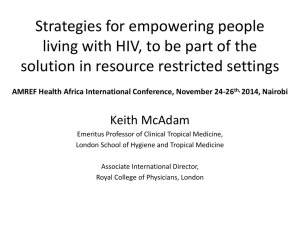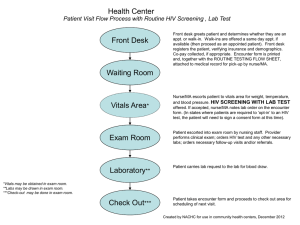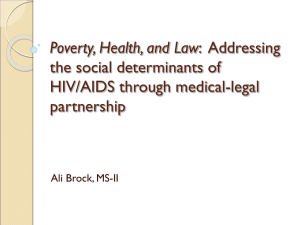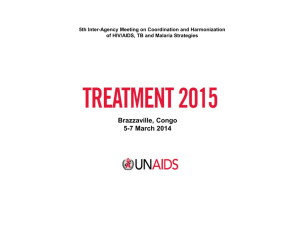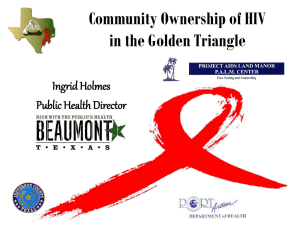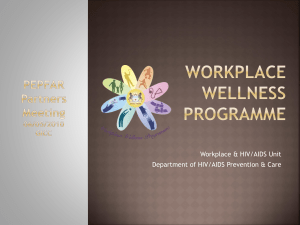The Protective Influence of Maternal
advertisement
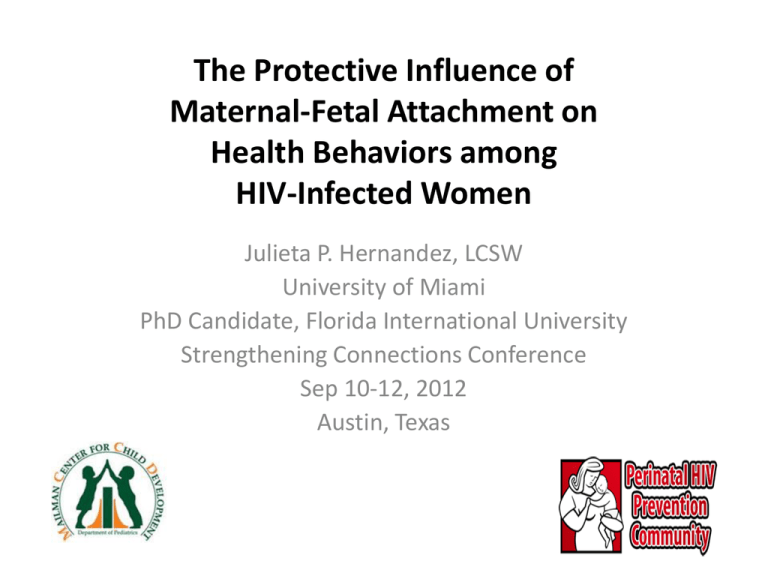
The Protective Influence of Maternal-Fetal Attachment on Health Behaviors among HIV-Infected Women Julieta P. Hernandez, LCSW University of Miami PhD Candidate, Florida International University Strengthening Connections Conference Sep 10-12, 2012 Austin, Texas Objectives • Learn about the psychosocial environment of HIV-infected pregnant women • Understand the conceptual link between MFA and maternal health behaviors • Learn about the protective role of MFA against poor maternal health behaviors and suboptimal infant care • Identify psychosocial contexts modifying the protective role of MFA. 2 Women living with HIV/AIDS • 1/4 people living with HIV/AIDS in US are women • Minority women are disproportionately affected by HIV/AIDS • Most new infections occur during childbearing age by heterosexual transmission 3 HIV Diagnosis in US Female Population, in 46 States, by Race/Ethnicity, 2010 Female Population N = 122,846,284 B/AA 12% Hisp/La 14% HIV Dx N = 9868 O 4% Other 7% White 67% B/AA 63% White 17% Hisp/La 16% http://www.cdc.gov/hiv/topics/surveillance/resources/slides/women/slides/Women.pdf 4 Diagnoses of HIV Infection, 2010 (46 States & 5 US Dependent Areas) Age at Diagnosis (in years) 13-19 20-24 25-34 N= 474 N =1110 N=2574 % % % % % Injection drug use 8.0 9.7 12.5 13.7 18.0 Heterosexual contact 92.0 90.2 87.4 86.2 82.0 Other 0.0 0.1 0.0 0.1 0.3 Total 100.0 100.0 100.0 100.0 100.0 Transmission Category 35-44 ≥45 N=2603 N=3407 http://www.cdc.gov/hiv/topics/surveillance/resources/slides/women/slides/Women.pdf 5 AIDS Diagnoses in US Women, 2010 Race/Ethnicity American Indian/Alaska Native Rate/ 100,000 pop 44 4.6 Asian 70 1.2 Black/African American 5422 33.7 Hispanic/Latino 1224 7.1 10 5.4 1275 1.5 197 13.1 8242 6.4 Native Hawaiian/Other Pacific Islander White Multiple races Total No. http://www.cdc.gov/hiv/topics/surveillance/resources/slides/women/slides/Women.pdf 6 Deaths among Females with HIV Diagnosis, 46 States, 2009 Race/ethnicity No. Rate American Indian/Alaska Native 26 2.8 Asian 19 0.4 3571 23.8 754 4.5 1 1.0 White 957 1.1 Multiple races 167 12.2 Black/African American Hispanic/Latino Native Hawaiian/Other Pacific Islander Total 5496 http://www.cdc.gov/hiv/topics/surveillance/resources/slides/women/slides/Women.pdf 7 HIV-infected pregnant women • Coping with HIV disease and preparing for motherhood • Fewer perinatally infected children • More HIV-infected pregnant women • Evolving unique characteristics of HIV-affected families http://www.actagainstaids.org/promote/ottl/brochures.html 8 http://hab.hrsa.gov/livinghistory/images/programs/part-d-highlights.gif 9 Vulnerability of HIV-affected mother-infant dyads • • • • • Poverty Depression or anxiety Drug use Social isolation Intimate partner violence 10 Protective factors in high-risk motherinfant dyads • Family functioning • Emotional and concrete support • Nurturing and attachment relationships • Skilful parenting 11 Maternal-Fetal Attachment (MFA) • Behaviors, thoughts, and feelings in women representing affiliation and interaction with unborn child • Desire to protect the fetus from harm: core emotion and altruistic function in MFA 12 MFA: an unexplored protective factor? • MFA begins the parentchild relationship • Protecting the fetus from harm blends with practicing all required maternal health behaviors 13 Maternal Health Behaviors • Pregnancy care results in positive pregnancy outcome • HIV medication adherence prevents motherto-child HIV transmission 14 Maternal Health Behaviors • Infant care adherence to HIV screening appointments confirms successful prevention of vertical transmission 15 Optimal HIV Medication Adherence in Pregnancy • • • • Barriers Drug use Parenting stress Single parent status Unplanned pregnancy Facilitators • Positive appraisal of pregnancy • Marital, family or social support • Concerns about welfare of fetus or newborn 16 MFA & Maternal Health Behaviors • The concept of maternal-fetal attachment orients inquiry toward relationship and protection, underscoring the importance of the child’s beginnings—embedded in multilayered familial and social environments—to shape future development. 17 The Dissertation Study 18 The Dissertation Study 19 Conceptual Framework • Strengths-based perspective (Saleebey, 1992) • Socio-ecological theory (Bronfenbrenner, 1979; Shonkoff & Phillips, 2000) • Biopsychosocial model of maternal stress processes in pregnancy (Dunkel Schetter et al., 2011) • Theory of the caregiving system (Solomon & George, 1996) 20 Multiple IRB processes FIU IRB JHS CRRC UM IRB NIH COC 21 Research Hypothesis Pregnancy Care DV1 MaternalFetal Attachment IV1 + + + Pregnancy HIV Med Adherence DV2 Infant Care Adherence DV3 22 Predictor Variables IV2: History of drug use IV3: Marital partner status IV4: Planned pregnancy status IV5: Time of HIV diagnosis 23 Research Hypothesis Pregnancy Care DV1 HIV Med Adherence DV2 Infant Care DV3 IV1 IV5 IV4 IV2 IV3 IV1= maternal-fetal attachment, IV2= history of drug use, IV3= marital partner status, IV4 = planned pregnancy status, and IV5= timing of HIV diagnosis 24 The PRIM Team 25 The PRIM Team 26 The MFCP PRIM Clinic • The Prenatal Immunology (PRIM) outpatient JHS clinic, staffed by UM OB/GYN Department • Concurrent prenatal and HIV care • Mental health assessments and behavior management sessions on stress reduction and partner disclosure strategies. • Infant care group sessions US Department of Health and Human Services Panel on Treatment of HIV-infected Pregnant Women and Prevention of Perinatal Transmission 27 The Pediatric Team 28 The MFCP Screening Clinic • 1st , 2nd , 4th visits (2, 4, 16 wks) – Virological tests performed on HIV-exposed infants to establish presumptive & definite HIV diagnosis exclusion. • 3rd visit – discontinue infant’s HIV medication prescribed at birth & counsel parent on virological test results • Mandated DCF report by clinic staff of nonattendance of any scheduled appt 29 Methodology • Prospective observational design • 92 HIV-infected English/Spanish speaking ≥ 24 weeks pregnant women recruited over 12 months from PRIM clinic • Survey socio-demographic and predictor variables (IV2-5) • Measure MFA (IV1) with MFAS (Cranley, 1981) 30 Methodology • Measure pregnancy care (DV1) with HPQ-II (Lindgren, 2005) • Abstract HIV medication adherence (DV2) and infant care adherence (DV3) data from medical records 31 Data Analysis • Preliminary analyses: accuracy of data entry, assumptions of multivariate analyses, missing data, outliers • Bivariate analyses: Pearson correlation, Chi square tests. • Multivariate analyses: standard and direct logistic multiple regression 32 Limitations & Solutions • Feasible to obtain necessary sample size? • Recruitment maximizes inclusion • Sample approximates entire local population • Exclusion of certain pregnant women with HIV • Instruments translated into Spanish 33 Limitations • Social desirability bias of self-reporting instruments • Sample skewed to woman already in prenatal care • Cross-sectional measures: Time 1 data & Solutions • Self-administration in familiar & comfortable clinic environment • Study design features optimize internal validity 34 Relevance for Social Work & Vulnerable Families • Theory: conceptual link between MFA and protection against suboptimal infant care • Practice: perinatal mental health interventions to promote resilience and protect against parental disruptions • Policy: preventive or promotional public health policies on early child development 35 Progress Report • Data collection began July 19, 2012 • Study well received by PRIM clinic staff and pregnant women • As of August 10, 2012 18 women have been invited to participate • 12 consented and 6 declined participation • No maternal or infant medical charts have been abstracted 36 Thank you 37 References • • • • • Bardeguez, A. D., Lindsey, J. C., Shanon, M., Tuomal, R. E., Cohn, S. E., Smith, E. Stek, A., Buschur, S., Cotter, A., Bettica, L., & Read, J. S. (2008) Adherence to antiretrovirals among US women during and after pregnancy. Journal of Acquired Immune Deficiency Syndrome, 48, 408-417. Brofenbrenner, U. (1979). The ecology of human development: Experiments by nature and design. Cambridge, MA: Harvard University Press. Cranley, M. S. (1981). Development of a tool for the measurement of maternal attachment during pregnancy. Nursing Research, 30, 281-294. D’Auria, J. P., Christian, B. J., & Miles, M. S. (2006). Being there for my baby: Early responses of an HIV-infected mother with an HIV-exposed infant. Journal of Pediatric Health Care, 20 (1), 11-18. Dunkel Schetter, C. (2011). Psychological science on pregnancy: Stress processes, biopsychosocial models, and emerging research issues. Annual Review of Psychology, 62, 531-558. 38 References • • • • • English, D. J., Thompson, R., Graham, J. C., Briggs, E. C. (2005). Toward a definition of neglect in young children. Child Maltreatment, 10, 190-206. Helfer, R. E. (1987). The perinatal period, a window of opportunity for enhancing parent-infant communication: An approach to prevention. Child Abuse & Neglect, 11, 565-579. Lindgren, K. (2005). Testing the Health Practices in Pregnancy Questionnaire-II. Journal of Obstetric, Gynecologic, and Neonatal Nursing, 34, 465-472. Mellins, C. A., Chu, C., Malee, K., Allison, S., Smith, R., Harris, L., Higgins, A., Zorrilla, C., Landesman, S., Serchuck, L. & Larussa, P.(2008). Adherence to antiretroviral treatment among pregnant and postpartum HIV-infected women. AIDS Care, 20(8), 958-968. Napravick, S., Royce, R., Walter E., & Lim, W. (2000). HIV-1 infected women and prenatal care utilization: barriers and facilitators. AIDS Patient Care and STDs, 14(8), 411-420. 39 References • Saleeby, D. (1992). Biology’s challenge to social work: embodying the person-in-environment perspective. Social Work, 37 (2), 112-118. • Sandbrook, S.P., & Adamson-Macedo, E. N. (2004). Maternal-fetal attachment: Searching for a new definition. Neuroendocrinology Letters, 25(Suppl.1), 169-182. • Shonkoff, J.P., & Phillips,D.A.(Eds.).(2000). From neurons to neighborhoods: The science of early child development. Wahington, DC:National Academy Press. • Solomon, J., & George, C. (1996). Defining the caregiving system: Toward a theory of care-giving. Infant Mental Health Journal, 17(3), 183-197. 40 Julieta P Hernandez, LCSW Mailman Center for Child Development Social Work Division Phone: 305 243 6864 Fax: 305 243 6865 jhernand@med.miami.edu 41
